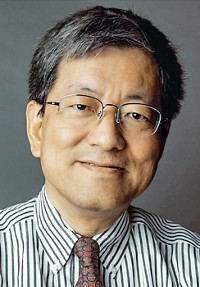Advertisement
Grab your lab coat. Let's get started
Welcome!
Welcome!
Create an account below to get 6 C&EN articles per month, receive newsletters and more - all free.
It seems this is your first time logging in online. Please enter the following information to continue.
As an ACS member you automatically get access to this site. All we need is few more details to create your reading experience.
Not you? Sign in with a different account.
Not you? Sign in with a different account.
ERROR 1
ERROR 1
ERROR 2
ERROR 2
ERROR 2
ERROR 2
ERROR 2
Password and Confirm password must match.
If you have an ACS member number, please enter it here so we can link this account to your membership. (optional)
ERROR 2
ACS values your privacy. By submitting your information, you are gaining access to C&EN and subscribing to our weekly newsletter. We use the information you provide to make your reading experience better, and we will never sell your data to third party members.
People
Biochemist Richard Armstrong Dies At 66
Vanderbilt professor and Biochemistry editor-in-chief made his mark in enzymology and structural biology
by Celia Henry Arnaud
June 22, 2015
Richard N. Armstrong, professor of biochemistry and chemistry at Vanderbilt University and editor-in-chief of Biochemistry, a journal published by the American Chemical Society, died June 18 after a brief illness. He was 66 years old.
Armstrong worked to elucidate the mechanisms of enzymes in the body that help detoxify foreign compounds from diet or the environment. One highlight was his work on glutathione S-transferases, a family of enzymes involved in the metabolism of electrophilic compounds such as epoxides and alkyl halides. He solved the first crystal structure of a glutathione transferase bound to glutathione, a biomolecule that acts as an antioxidant. He also elucidated mechanisms of hard-to-study membrane proteins.
“Richard spent his whole career at the vanguard of mechanistic enzymology, following in the tradition of pioneers such as Frank Westheimer by taking a rigorous bioorganic and biophysical approach to studying protein—especially enzyme—function,” says Charles R. Sanders, one of Armstrong’s colleagues in the biochemistry department at Vanderbilt. “He was fearless, adapting new methods and techniques to tackle the problem at hand.”
Armstrong received a bachelor’s degree in chemistry from Western Illinois University in 1970 and a Ph.D. in organic chemistry from Marquette University in 1975 under the direction of Norman E. Hoffman. He did postdoctoral research at the University of Chicago, where he worked with Emil T. Kaiser. Following a two-year stint at the National Institutes of Health, Armstrong joined the chemistry faculty at the University of Maryland. In 1995, he moved to Vanderbilt.
In addition to his research, Armstrong was active in ACS, which he joined in 1973. He had been editor-in-chief of Biochemistry since 2004. Before that, he was an associate editor of the Journal of the American Chemical Society. He also served as a councilor and chair of the ACS Division of Biological Chemistry. In 2014, he received an Arthur C. Cope Senior Scholar Award.
“Richard leaves a lasting legacy through his almost 12 years of editorial leadership of Biochemistry and his extensive research career,” says Brian D. Crawford, president of the ACS Publication Division, which also oversees the publication of C&EN. “He was passionate about expanding the global reach of Biochemistry and ACS Publications, for the benefit of the chemical community.”
Armstrong is survived by his wife, Mary Frances Clark; daughter, Kathryn Armstrong; son, Andrew Armstrong; eight siblings and their spouses; and 18 nieces and nephews.









Join the conversation
Contact the reporter
Submit a Letter to the Editor for publication
Engage with us on Twitter